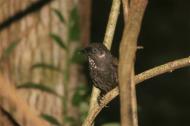
Ornithologists Zhou Fang and Jiang Aiwu first spotted the dark brown bird with white specks on its chest in 2005 and have since confirmed its identity as an undescribed species. They named it the Nonggang babbler, or Stachyris nonggangensis, for the region in China where it was found.
A formal description was published last year in The Auk, which is the quarterly journal of the Virginia-based American Ornithologists' Union.
"This is exciting evidence that there could be many more interesting discoveries awaiting ornithologists in China," said Birdlife International's Nigel Collar, which announced the discovery.
The new species resembles a wren-babbler in that it prefers running to flying, and seems to spend most of its time on the ground foraging for insects, Zhou said. About 100 Nonggang babblers have been identified so far in the Nonggang Natural Reserve in southwestern China.
A similar habitat exists straddling the border of northern Vietnam and southeast Yunnan, China, and it is possible the species may also be found there, Zhou said.
"The discovery shows that there are still some birds that haven't been (identified) yet in China, such a vast territory that is rich in biodiversity," Zhou said in a statement.
Xi Zhinong, the founder of conservation group Wild China, said similar finds are likely to become more common in China as laymen join professionals in the search for new species.
Because China was never explored like India and other countries that were colonized, and has regions that are difficult to access, researchers said they believe there are scores of small birds that remain to be identified.
"In recent years, more and more bird lovers and photographers are participating in the research of wild birds," Xi said. "The participation of those nonprofessionals has pushed forward the research of wildlife in China."
Birdlife's Mike Crosby noted that there are now 27 bird watching clubs across China.
"There is an emerging middle class in China with leisure time," said Crosby, who has worked extensively in the country.
But Zhou warned the country's rapid development could threaten many biologically rich areas like the karst - a network of limestone sinkholes marked by underground streams and caverns - before further discoveries are made.
"The fragility of the karst ecosystem and its destruction by people pose great threats to the bird's existence," he said.



Reader Comments
to our Newsletter